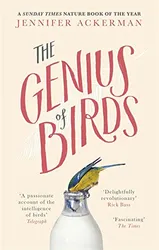Birds and humans have a common ancestor from around 300 million years ago, and since that time their brains have been evolving separately to those of mammals. Birds have a significantly different brain structure to our own and have developed many aspects of their intelligence independently. It’s not as extreme as the difference between human and cephalopod intelligence that was discussed in Other Minds, but there are many ways in which our intelligence differs from that of birds. In a sign of convergent evolution, however, bird brains have developed some structures that seem analogous to those in mammalian brains despite having evolved separately. This book aims to analyze the nature of bird intelligence, covering both the similarities between avian and mammalian intelligence, as well as the areas where birds have different and superior mental abilities. It also aims to dispel the myth of birds being stupid, as exemplified by insults such as “bird brain”.
The book discusses several different areas of intelligence (tool use, navigation abilities, social intelligence, artistic skills etc) with a chapter for each. We’re introduced to several bird species that demonstrate each type of intelligence, and even get to know some individual birds by name, as they became well-known by the researchers studying them. The book covers species from all over the globe, so while I was familiar with some of the species I also learned about birds from other places. There are some nice black and white sketches of some of the birds throughout the book.
I particularly liked the sections on problem solving, tool use and social intelligence. These seem like the forms of smartness that most closely resemble our own, and were the most convincing arguments for birds being smart in many of the same ways that humans are. One interesting point made in the book, however, was that it can be hard to distinguish between genuine intelligence and simply an instinct to explore new things. Bolder birds will often find a solution to some problem more quickly than more cautious birds, simply by trying things out more quickly, even if they are not actually any more intelligent.
While some of the same species come up in several chapters (corvids and parrots, as possibly the smartest birds of all, are intelligent in many different ways), there are many birds that only appear in a single chapter. Possibly because of this division, I wasn’t left entirely convinced that all birds have quite the same type of intelligence as humans do. There were a lot of behaviours that seemed explainable by inherited instinct rather than intelligence, and birds that are good at navigation but bad at puzzles probably aren’t intelligent in the same way we are. While the male bower bird goes to extraordinary lengths to make his display in order to attract a mate, does he really understand what he’s doing? (If he did, perhaps he’d find a less intensive form of attracting a mate!)
Some of the most interesting parts of the book are descriptions of experiments performed to test the thinking skills of birds. These range from puzzles that have to be solved in order to obtain food, to interfering with the bowers of bower birds to understand how they select the materials and colours used in their displays.
I should probably warn you that this book does contain descriptions of some experiments that sounded like they were quite harmful to the birds involved. This is not the author’s fault at all; she is simply reporting on the state of our knowledge at the time the book was written. This is a real science book and it doesn’t shy away from describing how we have come to learn about some aspects of bird behaviour. I don’t want to get into the ethics of such experiments, except to note that it could upset some readers in a book that would appeal to bird lovers in general.
The book is really well written, and there are a few subtle bird-related turns of phrase that kept me amused. I found this a very enjoyable book to read and learned a lot from it.
